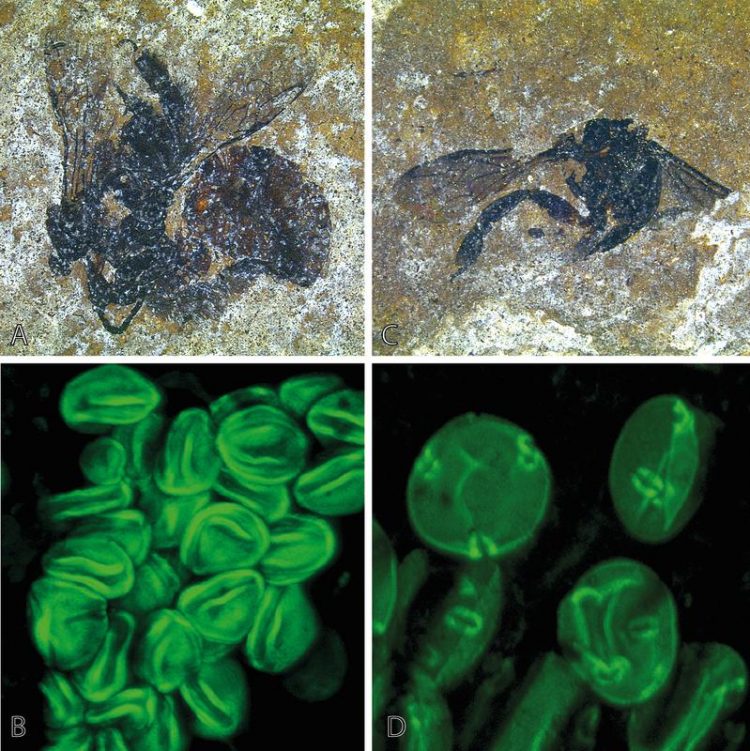Fossilized Bees Were Finicky Pollen Collectors

This image shows two fossilized bees and a few sample pollen types that were stuck to their back legs. © Photo: AG Wappler/Uni Bonn
The paleontologists studied fossilized bees from two different locations: the Messel Pit near Darmstadt and Eckfeld Maar in the Vulkaneifel. Both are former volcanic crater lakes, so deep that there was no oxygen to be found at the bottom. Any animals or plants that fell into the water were thus outstandingly preserved in the bottom sediment.
Nearly 50 million years ago, numerous bees met this very fate. Many of them were very well preserved in the oil shale rock. “For the first time, we are taking advantage of this circumstance in order to get a closer look at the pollen on the bees’ bodies,” explains Dr. Torsten Wappler. Dr. Wappler, an associate professor at the Steinmann Institute for Geology, Mineralogy and Paleontology at the University of Bonn, is the first author of the study.
Bees were both generalists and specialists
In their analyses, the researchers noticed a strange pattern: the pollen near the hymenoperans’ heads, chests and abdomens came from completely different plants. The pollen on their back legs, on the other hand, mainly came from evergreen bushes, which produce very similar blossoms.
The back legs of the long-extinct hymenoptera featured characteristic structures. The bees used them as transport containers (today’s honeybees have a very similar arrangement on their back legs). The insects used their front legs to comb pollen grains out of their body hair, and then transferred the pollen to their back legs.
However, this only worked if their front legs could reach the pollen easily – we human beings have trouble scratching between our shoulder blades, after all. “The bushes where the worker bees collected food for their larvae all had a similar blossom structure,” explains Dr. Wappler. “After they visited those blossoms, the pollen mainly stuck to parts of their bodies where it was easy to transfer to their legs.”
The prehistoric bees seemed to know which plants would give them a successful harvest, and they mainly targeted those blossoms. If they got hungry on the way, they landed on plants along their flight path and sipped the nectar. The pollen that stuck to their bodies shows how undiscriminating they were in their snacking.
Searching for food without wasting time
“This was a good strategy for the bees,” points out Dr. Wappler. “When they were looking for food for the larvae, they visited blossoms that offered a high yield with little effort. On the way there, on the other hand, they ate whatever they happened to find. So they didn’t waste any time looking for especially delicious or nutritious food.”
There was one thing that especially surprised the researchers: the bees from Eckfeld Maar were 44 million years old, while those from Messel were 48 million years old. Nonetheless, they had very similar pollen patterns on their legs and bodies. Even among the precursors of today’s bumblebees, the distribution was very similar. The dual strategy thus seems to have been common in various species, and stayed consistent for millions of years.
Even today, our honeybees use a similar approach. It is possible that the very first bees, which populated the earth about 100 million years ago, did the same thing. “Unfortunately there are no finds from that era that would allow us to analyze the pollen,” says Dr. Wappler.
Publication: Torsten Wappler, Conrad C. Labandeira, Michael S. Engel, Reinhard Zetter and Friðgeir Grímsson: Specialized and generalized pollen-collection strategies in an ancient bee lineage; “Current Biology”
Contact:
PD Dr. Torsten Wappler
Steinmann Institute for Geology, Mineralogy and Paleontology
University of Bonn
Tel. 0228/73-4682
Email: twappler@uni-bonn.de
http://dx.doi.org/10.1016/j.cub.2015.09.021 Publication
Media Contact
More Information:
http://www.uni-bonn.de/All latest news from the category: Earth Sciences
Earth Sciences (also referred to as Geosciences), which deals with basic issues surrounding our planet, plays a vital role in the area of energy and raw materials supply.
Earth Sciences comprises subjects such as geology, geography, geological informatics, paleontology, mineralogy, petrography, crystallography, geophysics, geodesy, glaciology, cartography, photogrammetry, meteorology and seismology, early-warning systems, earthquake research and polar research.
Newest articles

First-of-its-kind study uses remote sensing to monitor plastic debris in rivers and lakes
Remote sensing creates a cost-effective solution to monitoring plastic pollution. A first-of-its-kind study from researchers at the University of Minnesota Twin Cities shows how remote sensing can help monitor and…

Laser-based artificial neuron mimics nerve cell functions at lightning speed
With a processing speed a billion times faster than nature, chip-based laser neuron could help advance AI tasks such as pattern recognition and sequence prediction. Researchers have developed a laser-based…

Optimising the processing of plastic waste
Just one look in the yellow bin reveals a colourful jumble of different types of plastic. However, the purer and more uniform plastic waste is, the easier it is to…



